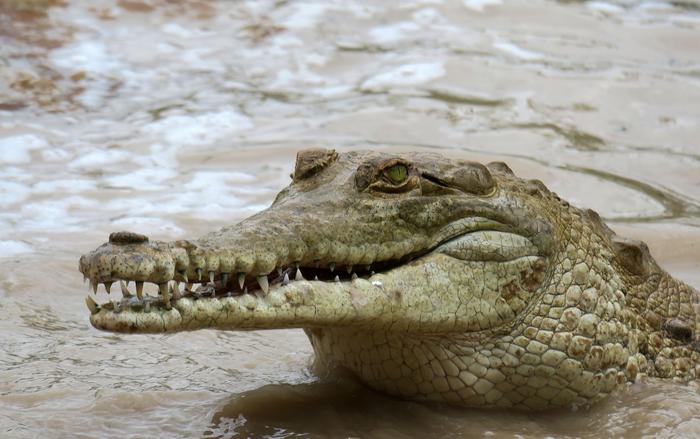The Orinoco crocodile (Crocodylus intermedius) is a critically endangered species native to the Orinoco River basin in Colombia and Venezuela. It is one of the largest crocodilian species in the world, reaching lengths of up to seven meters. Despite its impressive size, it is also the most endangered and least-studied of the New World crocodilians.

Credit: Mario Vargas-Ramírez
The Orinoco crocodile (Crocodylus intermedius) is a critically endangered species native to the Orinoco River basin in Colombia and Venezuela. It is one of the largest crocodilian species in the world, reaching lengths of up to seven meters. Despite its impressive size, it is also the most endangered and least-studied of the New World crocodilians.
The species has faced a severe population decline due to commercial overexploitation of its skin, which was highly sought after by the fashion industry of Europe, the USA and Japan in the 20th century. As a result, the current estimated global population stands at less than 250 adult individuals.
Recognizing the critical status of the species, herpetologist Federico Medem established a captive breeding program for the Orinoco crocodile in 1971 at the Roberto Franco Tropical Biological Station (RFTBS) in Villavicencio. Currently, the RFTBS houses over 600 individuals, making it the largest stock of this species and the only one in Colombia. Remarkably, there might be more adult crocodiles kept there than in the wild.
Despite the success of the captive breeding program, reintroduction of animals into the wild has been challenging. This is primarily due to the lack of a comprehensive genetic characterization that can determine whether the population is genetically viable and has no signs of inbreeding, which can result in reduced fitness at the individual and population level. To ensure the successful reintroduction of the species, it was crucial to have a robust and conclusive genetic assessment that confirms the population’s genetic health and viability.
“We felt a sense of urgency to determine the genetic viability of the population in order to proceed with the reintroduction of animals and establish new populations of the species in Colombia. Therefore, we conducted a comprehensive genetic characterization using fast-evolving molecular markers on a sample of 551 crocodiles,” explains Ana María Saldarriaga, a former researcher at the Universidad Nacional de Colombia who is currently pursuing a Ph.D. at Fordham University.
“Our findings showed that the individuals within the population possess sufficient genetic diversity and are suitable for reintroduction efforts, as well as for maintaining and enhancing the genetic variability of the ex-situ population.”
“We demonstrated that molecular data could be used to improve the management of ex-situ conservation programs well beyond what could be achieved with pedigree information alone,” she and her colleagues write in a study just published in the journal Nature Conservation.
Based on the findings of this study, the Colombian government, along with other public and private conservation institutions and agencies, can use the individuals identified in this research to initiate the establishment of new populations in regions where the species has been completely depleted.
“Today, it is widely recognized that top predators, such as crocodiles, play fundamental roles in both aquatic and terrestrial ecosystems. They have a significant impact on the nutrient cycle, regulate fish populations, and contribute to important cross-ecosystem engineering processes,” stated Mario Vargas-Ramírez, professor at the Genetics Institute of the Universidad Nacional de Colombia and director of the RFTBS.
“Therefore, the reintroduction of the Orinoco crocodile to the Orinoco region is an urgent priority. Additionally, as the Orinoco crocodile is considered an umbrella species, its recovery and conservation efforts will have a positive cascading effect, protecting a large number of species that coexist in the same environment.”
Original source:
Saldarriaga-Gómez AM, Ardila-Robayo MC, Medem F, Vargas-Ramírez M (2023) Hope is the last thing lost: Colombian captive-bred population of the critically endangered Orinoco crocodile (Crocodylus intermedius) is a genetic reservoir that could help to save the species from extinction. Nature Conservation 53: 85-103. https://doi.org/10.3897/natureconservation.53.104000
Journal
Nature Conservation
DOI
10.3897/natureconservation.53.104000
Article Title
Hope is the last thing lost: Colombian captive-bred population of the critically endangered Orinoco crocodile (Crocodylus intermedius) is a genetic reservoir that could help to save the species from extinction
Article Publication Date
24-Jul-2023




